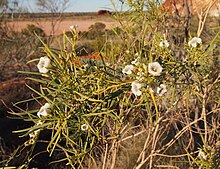| Duboisia hopwoodii | |
|---|---|

| |
| Scientific classification | |
| Kingdom: | Plantae |
| Clade: | Tracheophytes |
| Clade: | Angiosperms |
| Clade: | Eudicots |
| Clade: | Asterids |
| Order: | Solanales |
| Family: | Solanaceae |
| Genus: | Duboisia |
| Species: | D. hopwoodii |
| Binomial name | |
| Duboisia hopwoodii (F.Muell.) F.Muell. | |
| Synonyms | |
|
Anthocercis hopwoodii F.Muell. | |
Duboisia hopwoodii is a shrub native to the arid interior region of Australia. Common names include pituri, pitchuri thornapple or pitcheri.
Description
The species has an erect habit, usually growing to between 1 and 3 metres in height, with long, narrow leaves. Flowers are white and bell-shaped with violet-striped throats. These appear between June and November in the species' native range followed by purple-black, rounded berries which are 3 to 6 mm in diameter. Like other members of the Solanaceae family such as tobacco, D. hopwoodii contains nicotine.
Pituri
Main article: PituriIndigenous Australians mix the dried leaves of a small population of D. hopwoodii growing around the Mulligan River with wood ash to make a variety of pituri, the traditional Aboriginal chewing mixture. D. hopwoodii plants from this region are high in nicotine and low in nornicotine, whereas those found in some other parts of Australia can have very high levels of nornicotine and are sometimes used to contaminate water holes and stun animals to help in hunting. Unlike nicotine, nornicotine forms the carcinogen n-nitrosonornicotine in the human saliva. The paleontologist Dr Gavin Young named the fossil agnathan Pituriaspis doylei after the plant, as he thought he might be hallucinating, as though under the effects of pituri, upon viewing the fossil fish's bizarre form.
Taxonomy
The species was first formally described by botanist Ferdinand von Mueller in 1861 in Fragmenta phytographiae Australiae and given the name Anthocercis hopwoodii. In 1876, von Mueller transferred the species to the genus Duboisia.
References
- ^ "Duboisia hopwoodii ". Electronic Flora of South Australia Fact Sheet. State Herbarium of South Australia. Retrieved 2010-03-09.
- ^ "Duboisia hopwoodii". FloraBase. Western Australian Government Department of Biodiversity, Conservation and Attractions.
- ^ Gardner, C.A. (1981). Wildflowers of Western Australia. Perth: St George Books. ISBN 978-0867780079.
- Fagerström, Karl (December 2014). "Nicotine: Pharmacology, Toxicity and Therapeutic use" (PDF). Journal of Smoking Cessation. 9 (2): 53–59. doi:10.1017/jsc.2014.27. Retrieved 6 December 2020.
- Littlejohn, Katie. "Duboisia hopwoodii - Pituri Bush". Retrieved 2010-03-03.
- Knezevich, Aleksandar; Muzic, John; Hatsukami, Dorothy K.; Hecht, Stephen S.; Stepanov, Irina (1 February 2013). "Nornicotine Nitrosation in Saliva and Its Relation to Endogenous Synthesis of N′-Nitrosonornicotine in Humans". Nicotine & Tobacco Research. 15 (2): 591–595. doi:10.1093/ntr/nts172. PMC 3611998. PMID 22923602.
- Long, John A. The Rise of Fishes: 500 Million Years of Evolution. Baltimore: The Johns Hopkins University Press, 1996. ISBN 0-8018-5438-5
- "Duboisia hopwoodii". Australian Plant Name Index (APNI), IBIS database. Centre for Plant Biodiversity Research, Australian Government, Canberra. Retrieved 2010-03-09.